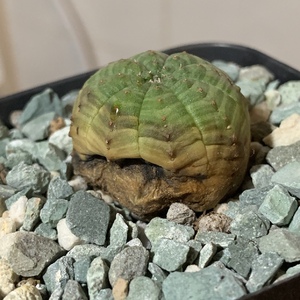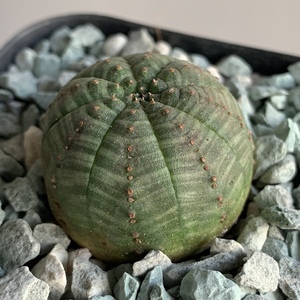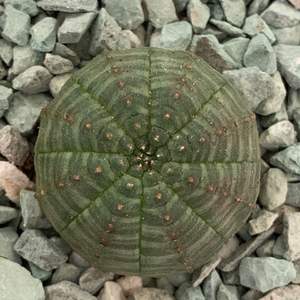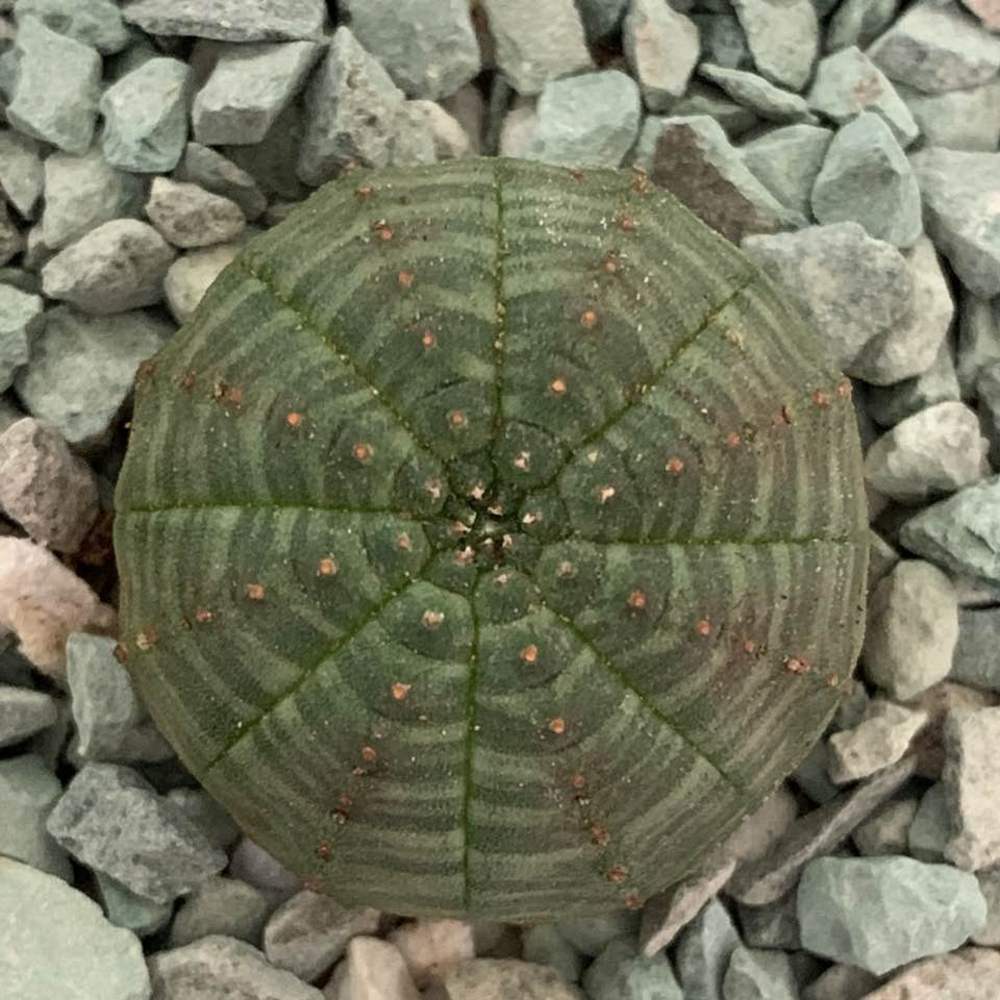植物经验
详细说明
Euphorbia obesa is a spineless, grey-green, dwarf, spherical succulent plant with transverse red-brown or purplish bands. It can grow up to 8 inches (20 cm) tall and up to 3.5 inches (9 cm) in diameter. It has rudimentary, caducous leaves and usually 8, vertical, broad, slightly raised ribs with shallow furrows in between. Small inflorescence is borne on short peduncle from stem apices. Female and male flower are born on different plants. The fruit is a slightly three angled capsule, up to 0.3 inch (7 mm) in diameter.
How to Grow and Care
As the Baseball Plant often grows in partial shade in its native habitat, place it on a windowsill where it receives sun for only part of the day, preferably during the morning. If you move the plant outdoors during the summer, adapt it to the increased light gradually and position it under the high shade of a tree or shrub, where it will receive direct sunlight only at times of the day when the sun is not directly overhead. If it begins to lose its plaid coloring, it needs more light.
Like most succulents, the Baseball Plant will rot in soggy soil, so keep it in a clay pot filled with a potting mix intended for cacti. Use a pot with at least one drainage hole. If you don’t have such a mix available, you can create your own by combining 1 part of regular potting soil with 1 part of coarse builders or horticultural sand and 1 part of horticultural pumice or poultry grit. From spring through autumn, water the plant thoroughly about once a week, until water runs from the pot’s drainage holes. At each watering, add a liquid 10-10-10 plant food at one-quarter strength, which should be about 2 drops of the plant food in 1 quart of water.
Light
As the Baseball Plant often grows in partial shade in its native habitat, place it on a windowsill where it receives sun for only part of the day, preferably during the morning. If you move the plant outdoors during the summer, adapt it to the increased light gradually and position it under the high shade of a tree or shrub, where it will receive direct sunlight only at times of the day when the sun is not directly overhead. If it begins to lose its plaid coloring, it needs more light.
Soil
Like most succulents, the Baseball Plant will rot in soggy soil, so keep it in a clay pot filled with a potting mix intended for cacti. Use a pot with at least one drainage hole. If you don’t have such a mix available, you can create your own by combining 1 part of regular potting soil with 1 part of coarse builders or horticultural sand and 1 part of horticultural pumice or poultry grit.
Watering and Fertilizing
From spring through autumn, water the plant thoroughly about once a week, until water runs from the pot’s drainage holes. At each watering, add a liquid 10-10-10 plant food at one-quarter strength, which should be about 2 drops of the plant food in 1 quart of water. Stop fertilizing the plant during its winter dormant period, and allow its soil to dry out before you water it again.
Pests
The Baseball Plant’s tiny leaves and equally minuscule, sweet-scented, greenish-yellow blooms appear in tubercles on the ribs, with male and female flowers being borne on separate plants. Because this succulent is mostly spherical stem, it seldom suffers from insect pests. If you see any, you should be able to remove them easily by dabbing them with a cotton swap dipped in rubbing alcohol.
Repotting
Only repot the plant when its girth grows large enough to press against the edges of its current container. Handle the plant carefully, preferably wearing gloves, because the white sap it exudes when broken can irritate the skin.
Planting and Protection
If you wish to grow the Baseball Plant in the ground outdoors, set it in fast-draining gravelly soil in a position where it will be shaded for part of the day. Once it is well established, it should require watering only about once every 10 to 14 days during dry periods. A succulent in the ground generally doesn’t need fertilizer, and you can easily dislodge any insects from its smooth surface with a blast of water from a spray bottle or hose. Only water or spray your plant in the morning to allow it to dry before evening. In Mediterranean-style climates with wet winters, you may need to protect the plant from excessive moisture during its dormant period by occasionally covering it with a makeshift plastic tent or cloche. Don’t leave the covering in place too long or the buildup of humidity underneath it may cause the rot you intended to prevent.
How to Grow and Care
As the Baseball Plant often grows in partial shade in its native habitat, place it on a windowsill where it receives sun for only part of the day, preferably during the morning. If you move the plant outdoors during the summer, adapt it to the increased light gradually and position it under the high shade of a tree or shrub, where it will receive direct sunlight only at times of the day when the sun is not directly overhead. If it begins to lose its plaid coloring, it needs more light.
Like most succulents, the Baseball Plant will rot in soggy soil, so keep it in a clay pot filled with a potting mix intended for cacti. Use a pot with at least one drainage hole. If you don’t have such a mix available, you can create your own by combining 1 part of regular potting soil with 1 part of coarse builders or horticultural sand and 1 part of horticultural pumice or poultry grit. From spring through autumn, water the plant thoroughly about once a week, until water runs from the pot’s drainage holes. At each watering, add a liquid 10-10-10 plant food at one-quarter strength, which should be about 2 drops of the plant food in 1 quart of water.
Light
As the Baseball Plant often grows in partial shade in its native habitat, place it on a windowsill where it receives sun for only part of the day, preferably during the morning. If you move the plant outdoors during the summer, adapt it to the increased light gradually and position it under the high shade of a tree or shrub, where it will receive direct sunlight only at times of the day when the sun is not directly overhead. If it begins to lose its plaid coloring, it needs more light.
Soil
Like most succulents, the Baseball Plant will rot in soggy soil, so keep it in a clay pot filled with a potting mix intended for cacti. Use a pot with at least one drainage hole. If you don’t have such a mix available, you can create your own by combining 1 part of regular potting soil with 1 part of coarse builders or horticultural sand and 1 part of horticultural pumice or poultry grit.
Watering and Fertilizing
From spring through autumn, water the plant thoroughly about once a week, until water runs from the pot’s drainage holes. At each watering, add a liquid 10-10-10 plant food at one-quarter strength, which should be about 2 drops of the plant food in 1 quart of water. Stop fertilizing the plant during its winter dormant period, and allow its soil to dry out before you water it again.
Pests
The Baseball Plant’s tiny leaves and equally minuscule, sweet-scented, greenish-yellow blooms appear in tubercles on the ribs, with male and female flowers being borne on separate plants. Because this succulent is mostly spherical stem, it seldom suffers from insect pests. If you see any, you should be able to remove them easily by dabbing them with a cotton swap dipped in rubbing alcohol.
Repotting
Only repot the plant when its girth grows large enough to press against the edges of its current container. Handle the plant carefully, preferably wearing gloves, because the white sap it exudes when broken can irritate the skin.
Planting and Protection
If you wish to grow the Baseball Plant in the ground outdoors, set it in fast-draining gravelly soil in a position where it will be shaded for part of the day. Once it is well established, it should require watering only about once every 10 to 14 days during dry periods. A succulent in the ground generally doesn’t need fertilizer, and you can easily dislodge any insects from its smooth surface with a blast of water from a spray bottle or hose. Only water or spray your plant in the morning to allow it to dry before evening. In Mediterranean-style climates with wet winters, you may need to protect the plant from excessive moisture during its dormant period by occasionally covering it with a makeshift plastic tent or cloche. Don’t leave the covering in place too long or the buildup of humidity underneath it may cause the rot you intended to prevent.
花相册 (3)



kensong
2018年12月06日

Too late to save. Not sure if it's fungal or rot.


kensong
2018年10月28日

This is my first growing diary. From Hee Garden RM48.00









